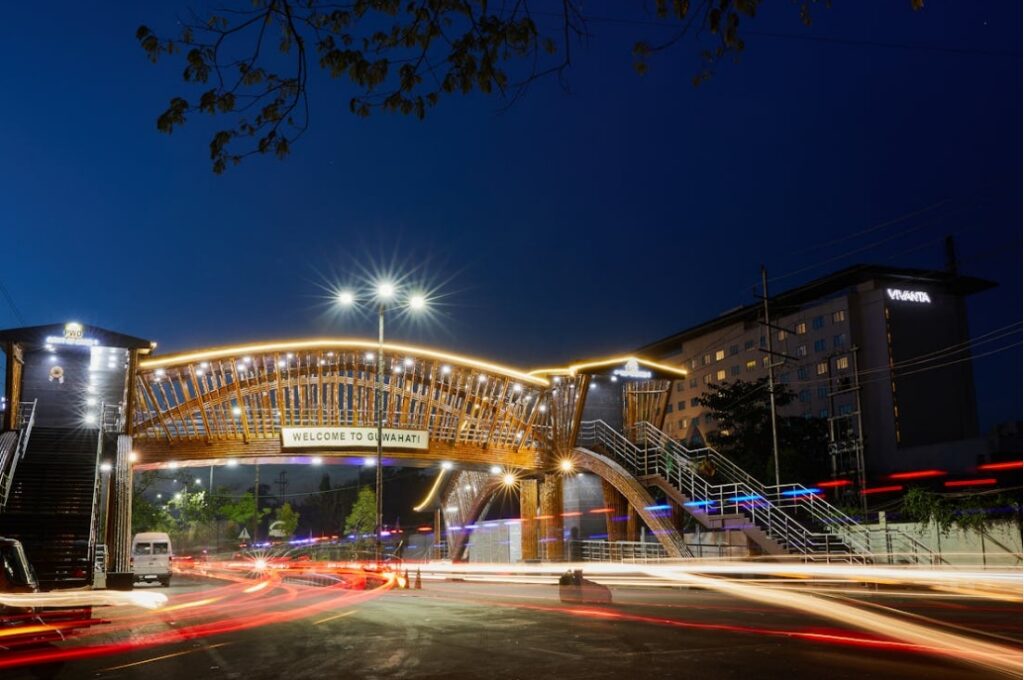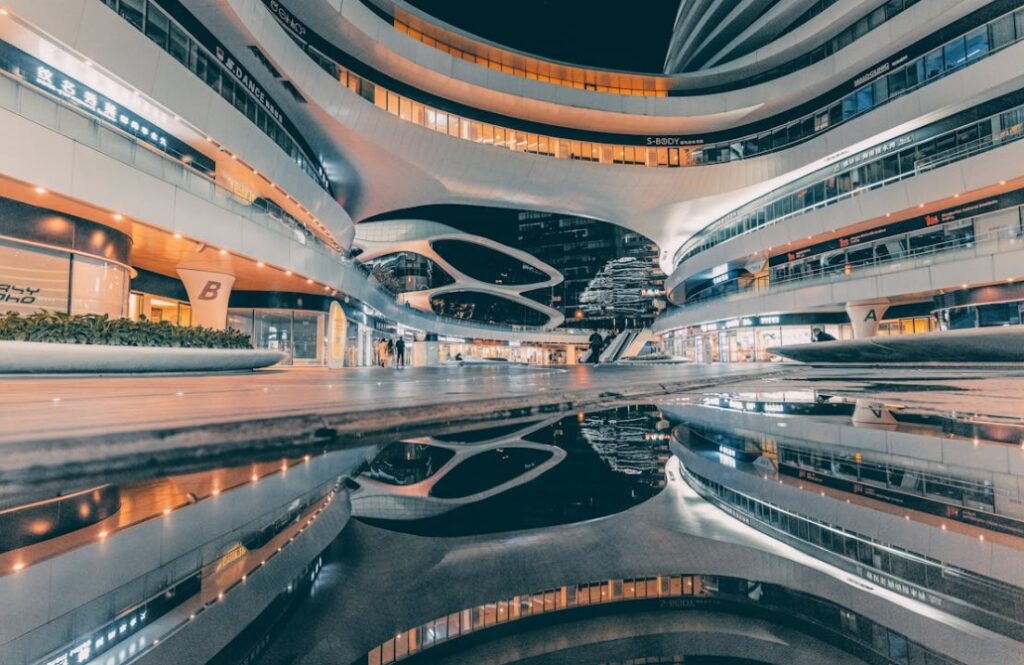ملاحظة: لضمان الدقة، تتبع هذه المقالة عملية إنشاء المحتوى ومراجعته وفقًا لـ فريق الخبراء Helian.
إنارة الشوارع (نوع من الإضاءة الخارجية التجارية) قد شهدت تحولات ملحوظة على مر السنين، ومع ظهور التقنيات الجديدة، يستمر التطور بوتيرة مذهلة. إن جوهر إضاءة الشوارع يتجاوز مجرد الإضاءة، فهي تلعب دورًا حاسمًا في السلامة وكفاءة الطاقة والجاذبية الجمالية في البيئات الحضرية. يتطرق هذا المقال إلى التصميمات المبتكرة في إضاءة الشوارع التجارية، مع التركيز على مصابيح إنارة الشوارع بمصابيح (ليد) وأضواء الشوارع التجارية والتكنولوجيا الحديثة التي تقود هذه التطورات.

تطور إنارة الشوارع
من مصابيح الغاز إلى مصابيح LED
تاريخياً، بدأت إنارة الشوارع بمصابيح الغاز، والتي كانت اختراعاً ثورياً في ذلك الوقت. ثم استُبدلت هذه المصابيح في نهاية المطاف بمصابيح كهربائية توفر كفاءة وسطوع أفضل. واليوم، أصبحت مصابيح إنارة الشوارع بمصابيح (ليد) في طليعة هذا التطور، حيث توفر كفاءة لا مثيل لها في استهلاك الطاقة وطول العمر وتأثيرًا بيئيًا أقل.
لماذا أضواء الشوارع LED؟
أحدثت تقنية الصمام الثنائي الباعث للضوء (ليد) ثورة في مفهوم إضاءة الشوارع. تستخدم مصابيح (ليد) طاقة أقل بكثير مقارنةً بحلول الإضاءة التقليدية مثل المصابيح المتوهجة والفلورية. كما أن عمرها الافتراضي أطول بكثير، مما يقلل من الحاجة إلى الاستبدال والصيانة المتكررة.
فوائد مصابيح الشوارع LED
- كفاءة الطاقة: تستهلك مصابيح LED طاقة أقل بما يصل إلى 80% من خيارات الإضاءة التقليدية.
- طول العمر الافتراضي: مع عمر افتراضي يصل إلى 50,000 ساعة، تدوم مصابيح LED أكثر من أنواع الإضاءة الأخرى.
- المتانة: مصابيح LED مقاومة للصدمات والاهتزازات والصدمات الخارجية، مما يجعلها مثالية للاستخدام الخارجي.
- التأثير البيئي: لا تحتوي مصابيح LED على عناصر سامة مثل الزئبق الموجود في بعض تقنيات الإضاءة القديمة.

تصاميم مبتكرة في أضواء الشوارع التجارية
أنظمة إنارة الشوارع الذكية
إن دمج التكنولوجيا الذكية في إضاءة الشوارع الخارجية التجارية سيغير قواعد اللعبة. يمكن التحكم في أنظمة إضاءة الشوارع الذكية عن بُعد، مما يسمح بإجراء تعديلات في الوقت الفعلي على مستويات الإضاءة بناءً على حركة المرور أو الظروف الجوية أو الوقت من اليوم. ولا يقتصر ذلك على تحسين كفاءة استخدام الطاقة فحسب، بل يعمل أيضًا على تحسين السلامة وتقليل التكاليف التشغيلية.
ميزات إضاءة الشوارع الذكية
- إضاءة متكيفة: يضبط السطوع تلقائياً بناءً على تدفق حركة المرور وظروف الطقس.
- المراقبة والتحكم عن بُعد: يسمح لمسؤولي المدينة بإدارة الإضاءة من موقع مركزي.
- جمع البيانات: قادرة على جمع البيانات عن الظروف البيئية وحركة المرور واستخدام الطاقة لمزيد من التحليل.
مصابيح الشوارع التي تعمل بالطاقة الشمسية
تجمع مصابيح الشوارع التجارية التي تعمل بالطاقة الشمسية بين تكنولوجيا مصابيح (ليد) وألواح الطاقة الشمسية، مما يوفر حلاً مستدامًا للإضاءة. تُعد هذه المصابيح مفيدة بشكل خاص في المناطق النائية التي لا تتوفر فيها طاقة الشبكة أو لا يمكن الاعتماد عليها. فمن خلال تسخير الطاقة الشمسية، تعمل مصابيح الشوارع هذه بشكل مستقل عن شبكة الكهرباء الرئيسية، مما يقلل من تكاليف الطاقة والبصمة الكربونية.
مزايا مصابيح الشوارع التي تعمل بالطاقة الشمسية
- الاستدامة: تستخدم الطاقة المتجددة، مما يقلل من الاعتماد على الوقود الأحفوري.
- فعالة من حيث التكلفة: يزيل تكاليف الكهرباء المرتبطة بإضاءة الشوارع.
- سهولة التركيب: لا يتطلب توصيل أسلاك معقدة أو حفر خنادق، مما يجعل التركيب أبسط وأكثر فعالية من حيث التكلفة.
اعتبارات التصميم الجمالي والوظيفي
التكامل المعماري
في التصميم الحضري الحديث، يعد التكامل الجمالي لإضاءة الشوارع مع المشهد المعماري أمراً ضرورياً. أضواء الشوارع التجارية متوفرة الآن بتصميمات متنوعة تتكامل مع الهندسة المعمارية المحيطة وتوفر إضاءة وظيفية.
أمثلة على التصاميم الجمالية
- أعمدة بسيطة: تصاميم أنيقة وغير مزعجة تندمج بسلاسة في البيئات الحضرية.
- التركيبات الزخرفية: أضواء الزينة التي تضفي طابعاً مميزاً على المناطق التاريخية أو المناطق ذات الطابع الخاص.
الحد من التلوث الضوئي
تركز التصميمات المبتكرة في مصابيح إنارة الشوارع بتقنية LED أيضًا على الحد من التلوث الضوئي. فمن خلال توجيه الضوء إلى الأسفل وتقليل الوهج إلى أدنى حد، تضمن هذه التصميمات استخدام الضوء بفعالية دون المساهمة في توهج سماء المدن.
مستقبل إنارة الشوارع التجارية

يبدو مستقبل إنارة الشوارع التجارية واعدًا في ظل التطورات المستمرة في مجال التكنولوجيا والتصميم. فمع سعي المدن إلى أن تصبح أكثر استدامة وكفاءة، سيزداد الطلب على حلول إنارة الشوارع المبتكرة.
الاتجاهات الناشئة
- التكامل مع إنترنت الأشياء: أضواء الشوارع التي تتواصل مع تقنيات المدن الذكية الأخرى لتحسين إدارة حركة المرور والسلامة العامة.
- تخزين الطاقة المحسّن: التقدم في تكنولوجيا البطاريات للمصابيح التي تعمل بالطاقة الشمسية، مما يسمح بتشغيلها لفترة أطول خلال الأيام الغائمة أو الليل.
- مواد متطورة: استخدام مواد خفيفة الوزن ومتينة في بناء مصابيح الشوارع لتحسين كفاءة التركيب والصيانة.
تعمل التصميمات الجديدة في إضاءة الشوارع على تغيير مدننا. يمكن أن يؤدي استخدام مصابيح LED والأنظمة الذكية والخيارات الصديقة للبيئة إلى جعل الأماكن أكثر أمانًا وتوفير الطاقة وتحسين حياة السكان. لا تزال الطريقة التي نضيء بها شوارعنا تتغير، ويبدو المستقبل مشرقاً وفعالاً.
نظرًا لأننا نركز على الاستدامة وبناء مدن أكثر ذكاءً، فإن حلول إنارة الشوارع الجديدة مهمة للغاية. توفر خيارات مثل مصابيح LED، والطاقة الشمسية، والتكنولوجيا الذكية العديد من الإمكانيات المثيرة.
من خلال مواكبة هذه الأفكار الجديدة، لا يمكن للمدن أن تضيء شوارعها فحسب، بل يمكنها أيضاً أن تخلق مستقبلاً أكثر اخضراراً.
